CST8152 Compilers Midterm Test - Principles, Techniques, & Tools
VerifiedAdded on 2022/09/02
|9
|1927
|21
Quiz and Exam
AI Summary
This document presents the solution to a midterm test for the CST8152 Compilers course, focusing on the principles, techniques, and tools of compiler design. The test includes a variety of question types, such as multiple-choice, true/false, and short answer questions, covering key concepts like compiler components (lexical analyzer, syntax analyzer, semantic analyzer, code optimizer), context-free grammars, parse trees, ambiguous grammars, lexical analysis, regular expressions, and finite automata (DFA, NFA). The assignment also explores topics like bootstrapping compilers, lexical analysis implementation, and the relationship between regular expressions and context-free grammars. Furthermore, the test includes questions on defining language tokens, regular expressions, and constructing transition tables, and also contains bonus questions related to grammar and regular expressions. The test aims to assess students' understanding of compiler design and implementation concepts.
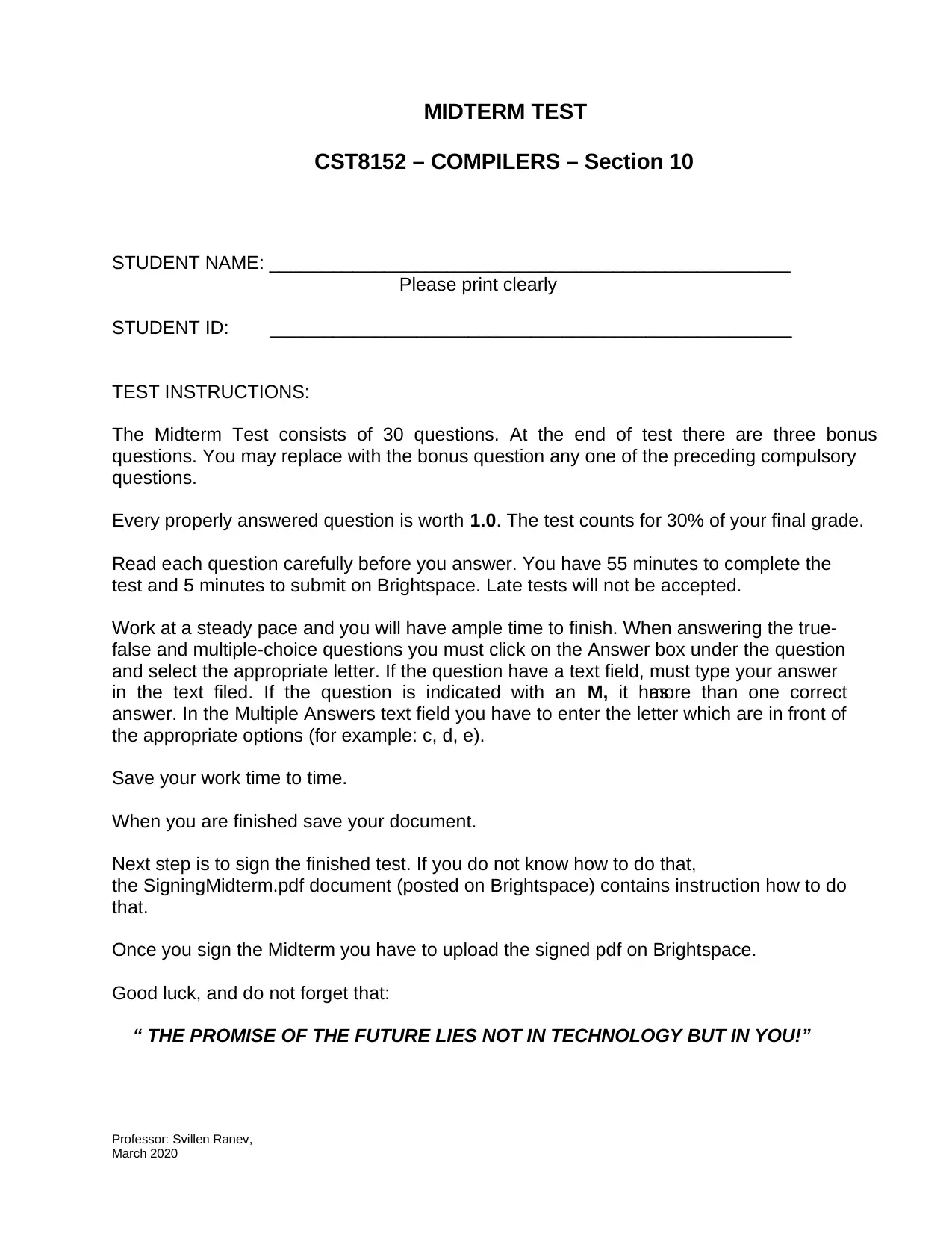
MIDTERM TEST
CST8152 – COMPILERS – Section 10
STUDENT NAME: __________________________________________________
Please print clearly
STUDENT ID: __________________________________________________
TEST INSTRUCTIONS:
The Midterm Test consists of 30 questions. At the end of test there are three bonus
questions. You may replace with the bonus question any one of the preceding compulsory
questions.
Every properly answered question is worth 1.0. The test counts for 30% of your final grade.
Read each question carefully before you answer. You have 55 minutes to complete the
test and 5 minutes to submit on Brightspace. Late tests will not be accepted.
Work at a steady pace and you will have ample time to finish. When answering the true-
false and multiple-choice questions you must click on the Answer box under the question
and select the appropriate letter. If the question have a text field, must type your answer
in the text filed. If the question is indicated with an M, it hasmore than one correct
answer. In the Multiple Answers text field you have to enter the letter which are in front of
the appropriate options (for example: c, d, e).
Save your work time to time.
When you are finished save your document.
Next step is to sign the finished test. If you do not know how to do that,
the SigningMidterm.pdf document (posted on Brightspace) contains instruction how to do
that.
Once you sign the Midterm you have to upload the signed pdf on Brightspace.
Good luck, and do not forget that:
“ THE PROMISE OF THE FUTURE LIES NOT IN TECHNOLOGY BUT IN YOU!”
Professor: Svillen Ranev,
March 2020
CST8152 – COMPILERS – Section 10
STUDENT NAME: __________________________________________________
Please print clearly
STUDENT ID: __________________________________________________
TEST INSTRUCTIONS:
The Midterm Test consists of 30 questions. At the end of test there are three bonus
questions. You may replace with the bonus question any one of the preceding compulsory
questions.
Every properly answered question is worth 1.0. The test counts for 30% of your final grade.
Read each question carefully before you answer. You have 55 minutes to complete the
test and 5 minutes to submit on Brightspace. Late tests will not be accepted.
Work at a steady pace and you will have ample time to finish. When answering the true-
false and multiple-choice questions you must click on the Answer box under the question
and select the appropriate letter. If the question have a text field, must type your answer
in the text filed. If the question is indicated with an M, it hasmore than one correct
answer. In the Multiple Answers text field you have to enter the letter which are in front of
the appropriate options (for example: c, d, e).
Save your work time to time.
When you are finished save your document.
Next step is to sign the finished test. If you do not know how to do that,
the SigningMidterm.pdf document (posted on Brightspace) contains instruction how to do
that.
Once you sign the Midterm you have to upload the signed pdf on Brightspace.
Good luck, and do not forget that:
“ THE PROMISE OF THE FUTURE LIES NOT IN TECHNOLOGY BUT IN YOU!”
Professor: Svillen Ranev,
March 2020
Paraphrase This Document
Need a fresh take? Get an instant paraphrase of this document with our AI Paraphraser
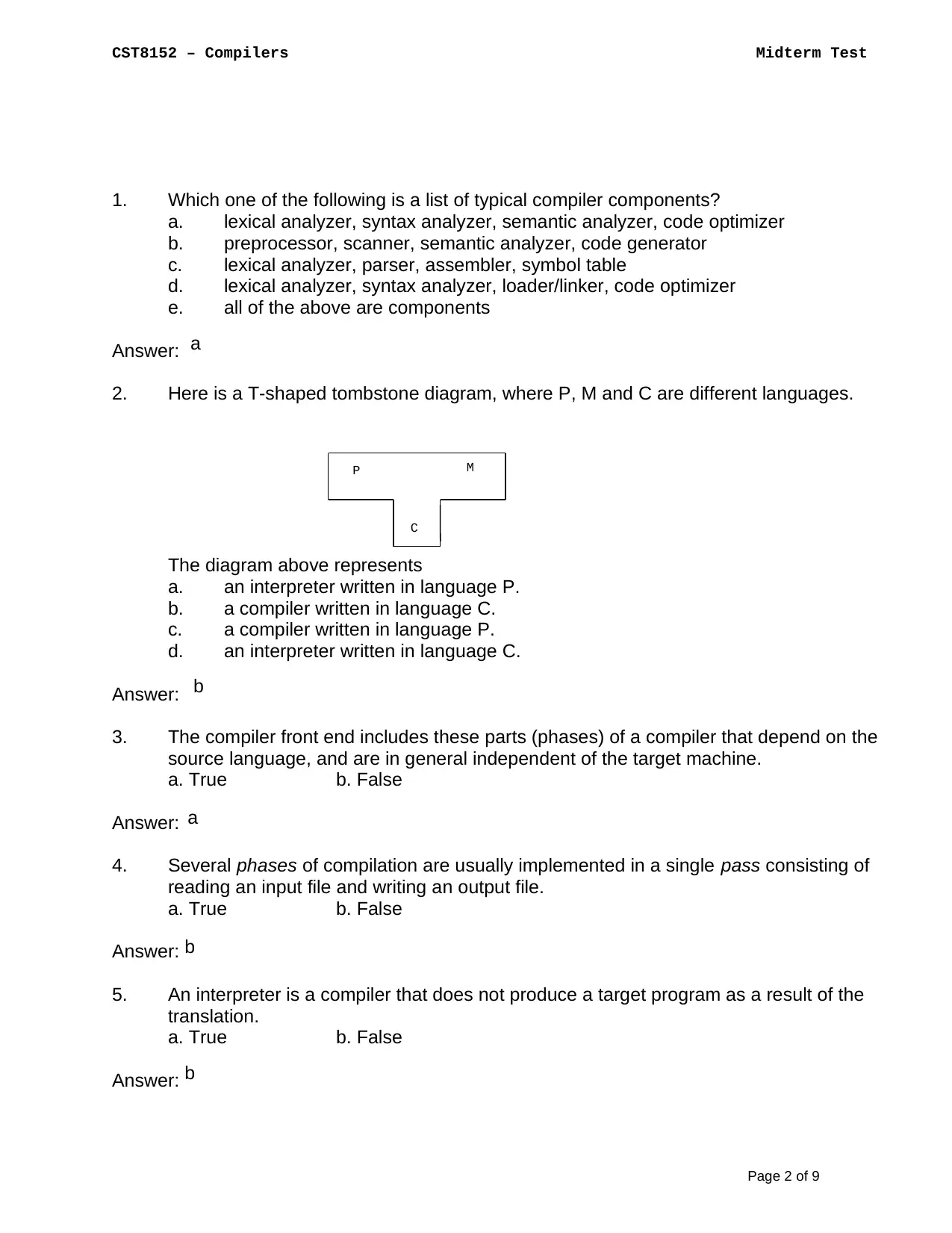
CST8152 – Compilers Midterm Test
Page 2 of 9
1. Which one of the following is a list of typical compiler components?
a. lexical analyzer, syntax analyzer, semantic analyzer, code optimizer
b. preprocessor, scanner, semantic analyzer, code generator
c. lexical analyzer, parser, assembler, symbol table
d. lexical analyzer, syntax analyzer, loader/linker, code optimizer
e. all of the above are components
Answer:
2. Here is a T-shaped tombstone diagram, where P, M and C are different languages.
The diagram above represents
a. an interpreter written in language P.
b. a compiler written in language C.
c. a compiler written in language P.
d. an interpreter written in language C.
Answer:
3. The compiler front end includes these parts (phases) of a compiler that depend on the
source language, and are in general independent of the target machine.
a. True b. False
Answer:
4. Several phases of compilation are usually implemented in a single pass consisting of
reading an input file and writing an output file.
a. True b. False
Answer:
5. An interpreter is a compiler that does not produce a target program as a result of the
translation.
a. True b. False
Answer:
P
C
M
a
b
a
b
b
Page 2 of 9
1. Which one of the following is a list of typical compiler components?
a. lexical analyzer, syntax analyzer, semantic analyzer, code optimizer
b. preprocessor, scanner, semantic analyzer, code generator
c. lexical analyzer, parser, assembler, symbol table
d. lexical analyzer, syntax analyzer, loader/linker, code optimizer
e. all of the above are components
Answer:
2. Here is a T-shaped tombstone diagram, where P, M and C are different languages.
The diagram above represents
a. an interpreter written in language P.
b. a compiler written in language C.
c. a compiler written in language P.
d. an interpreter written in language C.
Answer:
3. The compiler front end includes these parts (phases) of a compiler that depend on the
source language, and are in general independent of the target machine.
a. True b. False
Answer:
4. Several phases of compilation are usually implemented in a single pass consisting of
reading an input file and writing an output file.
a. True b. False
Answer:
5. An interpreter is a compiler that does not produce a target program as a result of the
translation.
a. True b. False
Answer:
P
C
M
a
b
a
b
b
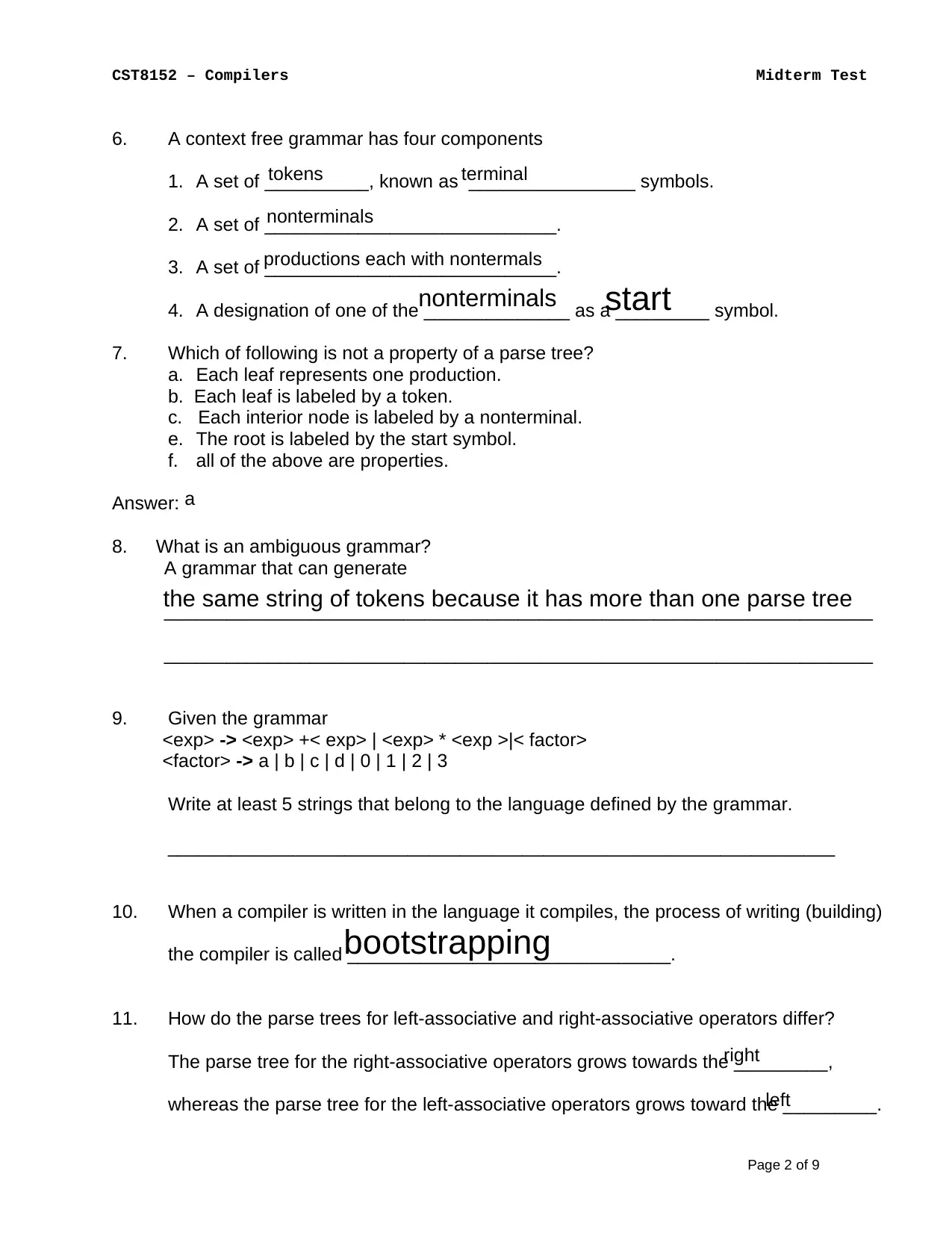
CST8152 – Compilers Midterm Test
Page 2 of 9
6. A context free grammar has four components
1. A set of __________, known as ________________ symbols.
2. A set of ____________________________.
3. A set of ____________________________.
4. A designation of one of the ______________ as a _________ symbol.
7. Which of following is not a property of a parse tree?
a. Each leaf represents one production.
b. Each leaf is labeled by a token.
c. Each interior node is labeled by a nonterminal.
e. The root is labeled by the start symbol.
f. all of the above are properties.
Answer:
8. What is an ambiguous grammar?
A grammar that can generate
____________________________________________________________________
____________________________________________________________________
9. Given the grammar
<exp> -> <exp> +< exp> | <exp> * <exp >|< factor>
<factor> -> a | b | c | d | 0 | 1 | 2 | 3
Write at least 5 strings that belong to the language defined by the grammar.
________________________________________________________________
10. When a compiler is written in the language it compiles, the process of writing (building)
the compiler is called _______________________________.
11. How do the parse trees for left-associative and right-associative operators differ?
The parse tree for the right-associative operators grows towards the _________,
whereas the parse tree for the left-associative operators grows toward the _________.
tokens terminal
nonterminals
productions each with nontermals
nonterminals start
a
the same string of tokens because it has more than one parse tree
bootstrapping
right
left
Page 2 of 9
6. A context free grammar has four components
1. A set of __________, known as ________________ symbols.
2. A set of ____________________________.
3. A set of ____________________________.
4. A designation of one of the ______________ as a _________ symbol.
7. Which of following is not a property of a parse tree?
a. Each leaf represents one production.
b. Each leaf is labeled by a token.
c. Each interior node is labeled by a nonterminal.
e. The root is labeled by the start symbol.
f. all of the above are properties.
Answer:
8. What is an ambiguous grammar?
A grammar that can generate
____________________________________________________________________
____________________________________________________________________
9. Given the grammar
<exp> -> <exp> +< exp> | <exp> * <exp >|< factor>
<factor> -> a | b | c | d | 0 | 1 | 2 | 3
Write at least 5 strings that belong to the language defined by the grammar.
________________________________________________________________
10. When a compiler is written in the language it compiles, the process of writing (building)
the compiler is called _______________________________.
11. How do the parse trees for left-associative and right-associative operators differ?
The parse tree for the right-associative operators grows towards the _________,
whereas the parse tree for the left-associative operators grows toward the _________.
tokens terminal
nonterminals
productions each with nontermals
nonterminals start
a
the same string of tokens because it has more than one parse tree
bootstrapping
right
left
⊘ This is a preview!⊘
Do you want full access?
Subscribe today to unlock all pages.

Trusted by 1+ million students worldwide
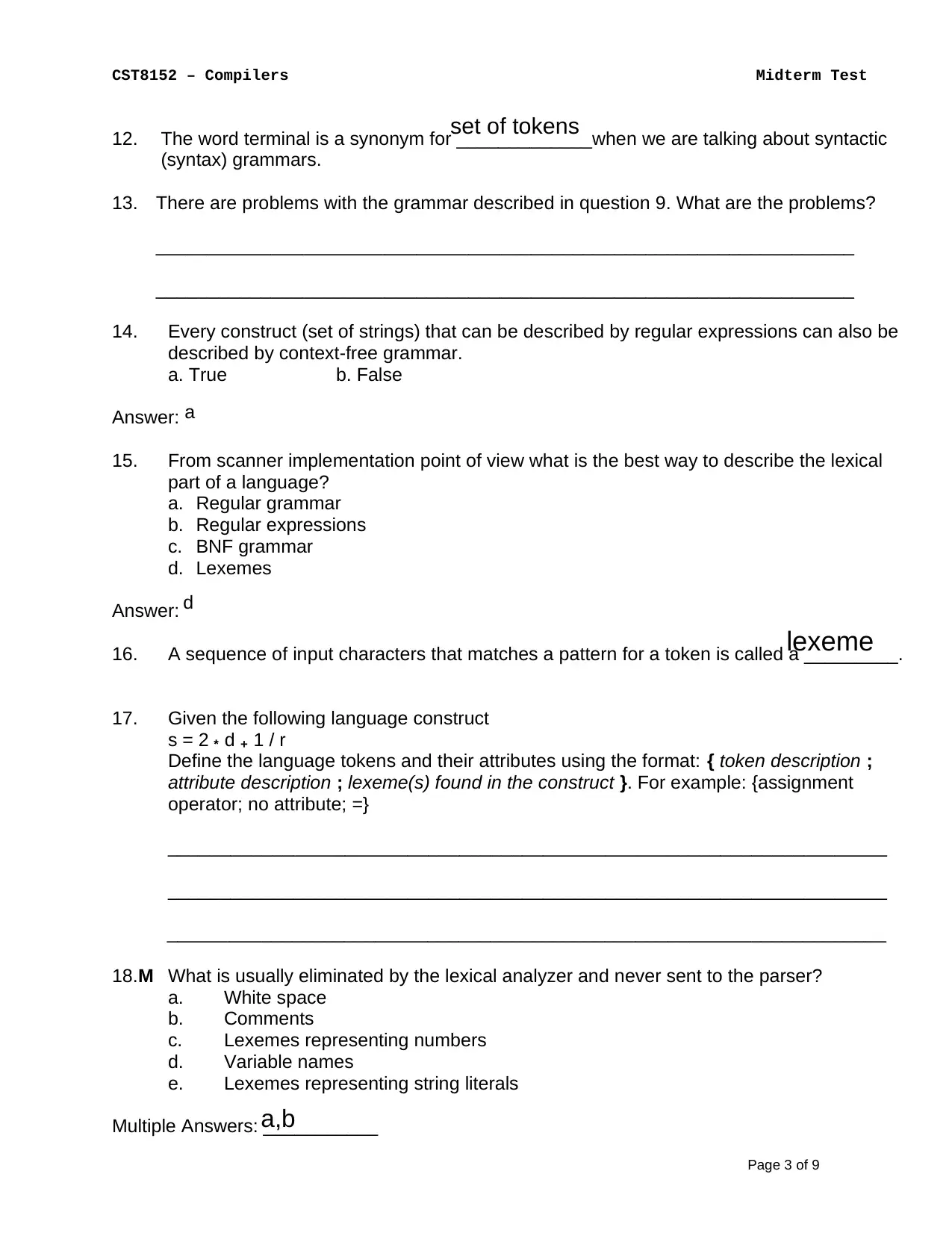
CST8152 – Compilers Midterm Test
Page 3 of 9
12. The word terminal is a synonym for _____________when we are talking about syntactic
(syntax) grammars.
13. There are problems with the grammar described in question 9. What are the problems?
___________________________________________________________________
___________________________________________________________________
14. Every construct (set of strings) that can be described by regular expressions can also be
described by context-free grammar.
a. True b. False
Answer:
15. From scanner implementation point of view what is the best way to describe the lexical
part of a language?
a. Regular grammar
b. Regular expressions
c. BNF grammar
d. Lexemes
Answer:
16. A sequence of input characters that matches a pattern for a token is called a _________.
17. Given the following language construct
s = 2 * d + 1 / r
Define the language tokens and their attributes using the format: { token description ;
attribute description ; lexeme(s) found in the construct }. For example: {assignment
operator; no attribute; =}
_____________________________________________________________________
_____________________________________________________________________
_____________________________________________________________________
18.M What is usually eliminated by the lexical analyzer and never sent to the parser?
a. White space
b. Comments
c. Lexemes representing numbers
d. Variable names
e. Lexemes representing string literals
Multiple Answers: ___________
set of tokens
a
d
lexeme
a,b
Page 3 of 9
12. The word terminal is a synonym for _____________when we are talking about syntactic
(syntax) grammars.
13. There are problems with the grammar described in question 9. What are the problems?
___________________________________________________________________
___________________________________________________________________
14. Every construct (set of strings) that can be described by regular expressions can also be
described by context-free grammar.
a. True b. False
Answer:
15. From scanner implementation point of view what is the best way to describe the lexical
part of a language?
a. Regular grammar
b. Regular expressions
c. BNF grammar
d. Lexemes
Answer:
16. A sequence of input characters that matches a pattern for a token is called a _________.
17. Given the following language construct
s = 2 * d + 1 / r
Define the language tokens and their attributes using the format: { token description ;
attribute description ; lexeme(s) found in the construct }. For example: {assignment
operator; no attribute; =}
_____________________________________________________________________
_____________________________________________________________________
_____________________________________________________________________
18.M What is usually eliminated by the lexical analyzer and never sent to the parser?
a. White space
b. Comments
c. Lexemes representing numbers
d. Variable names
e. Lexemes representing string literals
Multiple Answers: ___________
set of tokens
a
d
lexeme
a,b
Paraphrase This Document
Need a fresh take? Get an instant paraphrase of this document with our AI Paraphraser
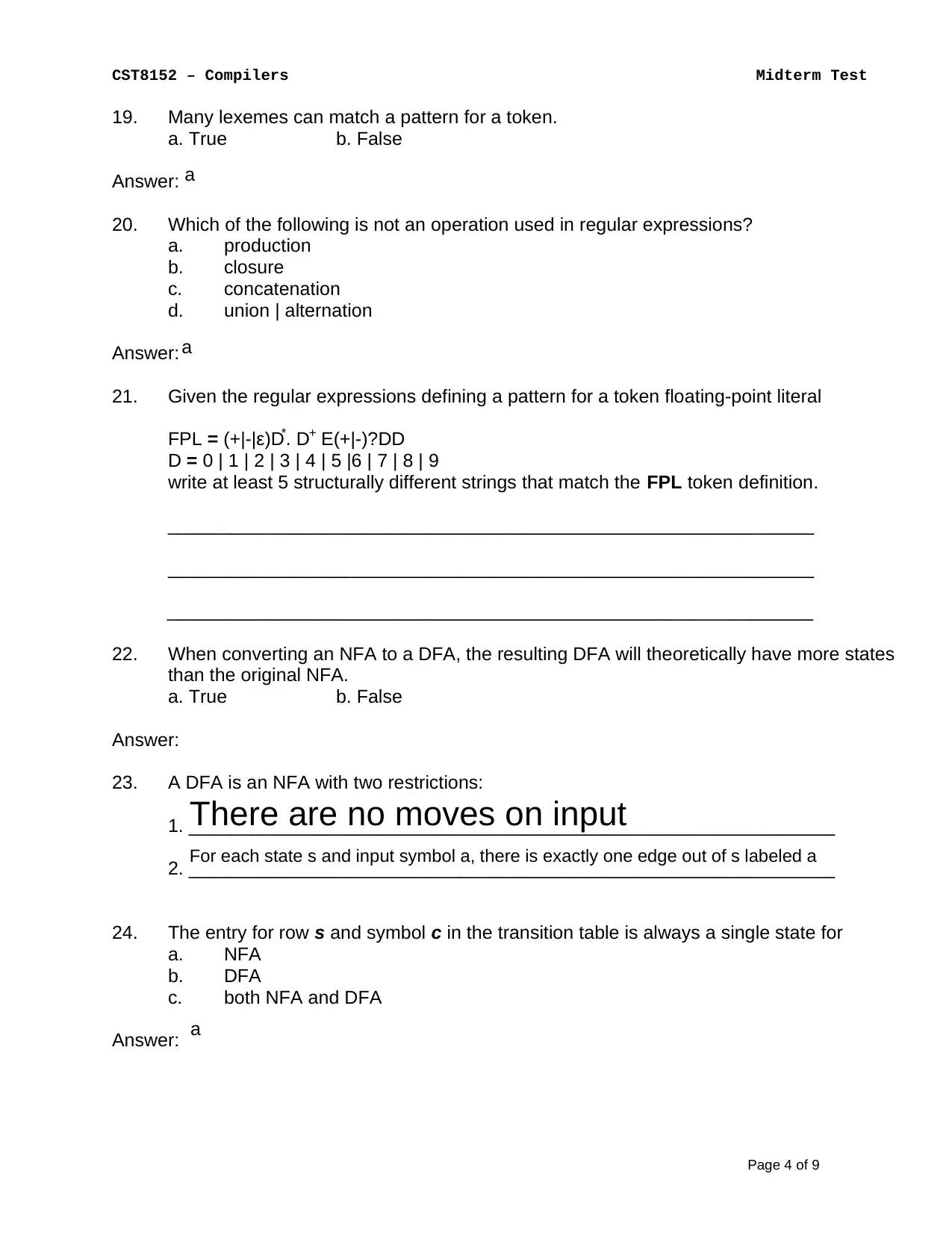
CST8152 – Compilers Midterm Test
Page 4 of 9
19. Many lexemes can match a pattern for a token.
a. True b. False
Answer:
20. Which of the following is not an operation used in regular expressions?
a. production
b. closure
c. concatenation
d. union | alternation
Answer:
21. Given the regular expressions defining a pattern for a token floating-point literal
FPL = (+|-|ε)D*. D+ E(+|-)?DD
D = 0 | 1 | 2 | 3 | 4 | 5 |6 | 7 | 8 | 9
write at least 5 structurally different strings that match the FPL token definition.
______________________________________________________________
______________________________________________________________
______________________________________________________________
22. When converting an NFA to a DFA, the resulting DFA will theoretically have more states
than the original NFA.
a. True b. False
Answer:
23. A DFA is an NFA with two restrictions:
1. ______________________________________________________________
2. ______________________________________________________________
24. The entry for row s and symbol c in the transition table is always a single state for
a. NFA
b. DFA
c. both NFA and DFA
Answer:
a
a
There are no moves on input
For each state s and input symbol a, there is exactly one edge out of s labeled a
a
Page 4 of 9
19. Many lexemes can match a pattern for a token.
a. True b. False
Answer:
20. Which of the following is not an operation used in regular expressions?
a. production
b. closure
c. concatenation
d. union | alternation
Answer:
21. Given the regular expressions defining a pattern for a token floating-point literal
FPL = (+|-|ε)D*. D+ E(+|-)?DD
D = 0 | 1 | 2 | 3 | 4 | 5 |6 | 7 | 8 | 9
write at least 5 structurally different strings that match the FPL token definition.
______________________________________________________________
______________________________________________________________
______________________________________________________________
22. When converting an NFA to a DFA, the resulting DFA will theoretically have more states
than the original NFA.
a. True b. False
Answer:
23. A DFA is an NFA with two restrictions:
1. ______________________________________________________________
2. ______________________________________________________________
24. The entry for row s and symbol c in the transition table is always a single state for
a. NFA
b. DFA
c. both NFA and DFA
Answer:
a
a
There are no moves on input
For each state s and input symbol a, there is exactly one edge out of s labeled a
a
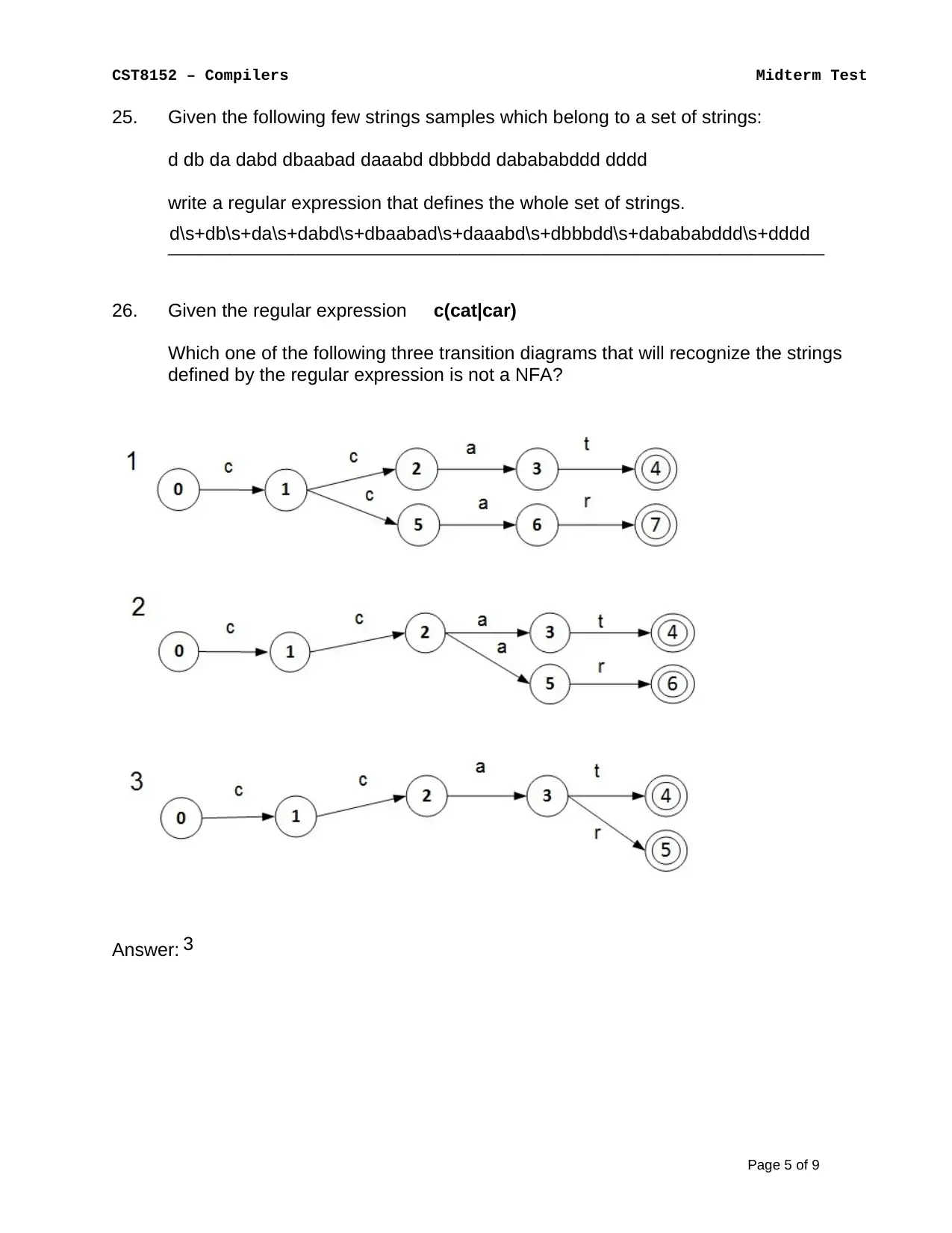
CST8152 – Compilers Midterm Test
Page 5 of 9
25. Given the following few strings samples which belong to a set of strings:
d db da dabd dbaabad daaabd dbbbdd dabababddd dddd
write a regular expression that defines the whole set of strings.
_______________________________________________________________
26. Given the regular expression c(cat|car)
Which one of the following three transition diagrams that will recognize the strings
defined by the regular expression is not a NFA?
Answer:
d\s+db\s+da\s+dabd\s+dbaabad\s+daaabd\s+dbbbdd\s+dabababddd\s+dddd
3
Page 5 of 9
25. Given the following few strings samples which belong to a set of strings:
d db da dabd dbaabad daaabd dbbbdd dabababddd dddd
write a regular expression that defines the whole set of strings.
_______________________________________________________________
26. Given the regular expression c(cat|car)
Which one of the following three transition diagrams that will recognize the strings
defined by the regular expression is not a NFA?
Answer:
d\s+db\s+da\s+dabd\s+dbaabad\s+daaabd\s+dbbbdd\s+dabababddd\s+dddd
3
⊘ This is a preview!⊘
Do you want full access?
Subscribe today to unlock all pages.

Trusted by 1+ million students worldwide
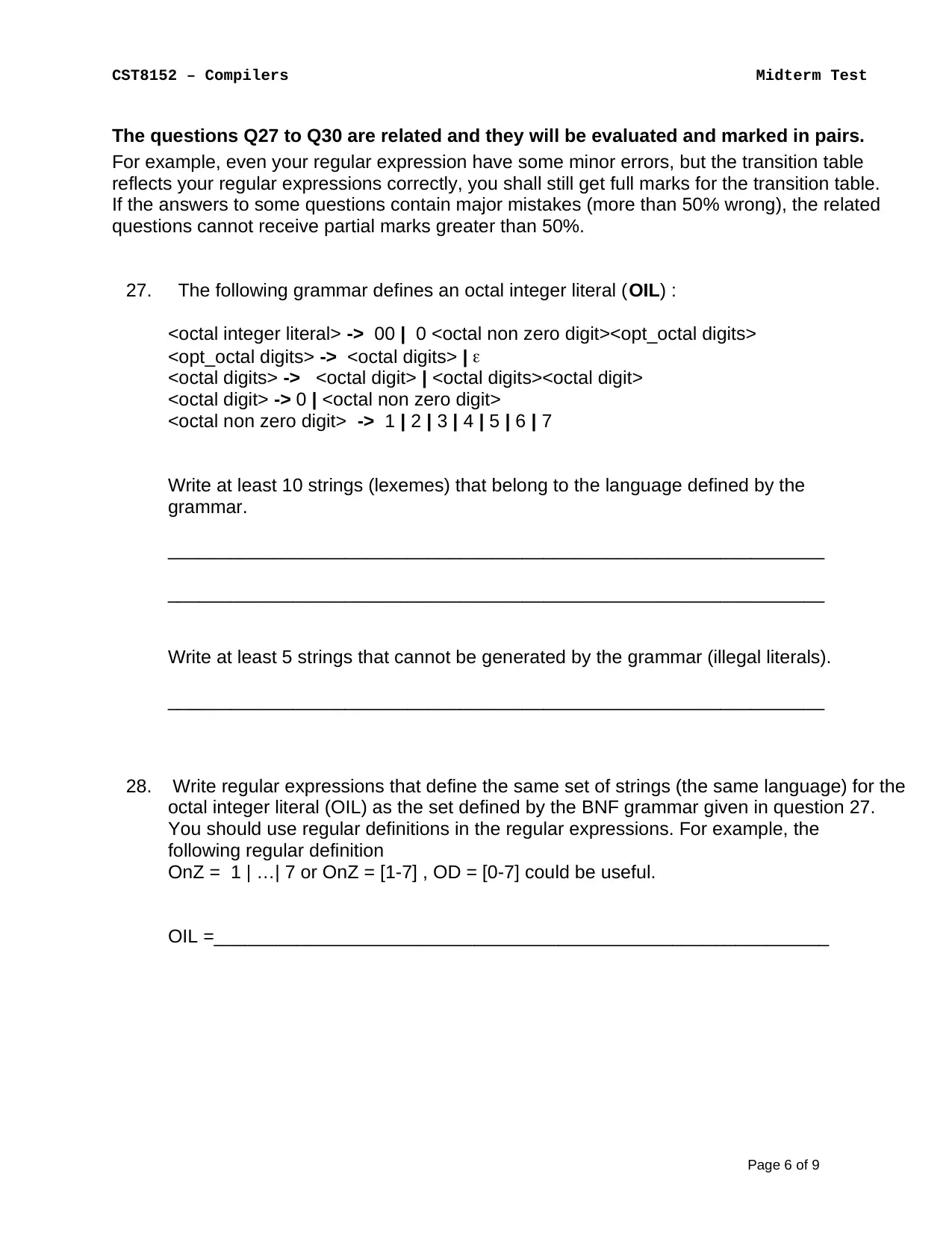
CST8152 – Compilers Midterm Test
Page 6 of 9
The questions Q27 to Q30 are related and they will be evaluated and marked in pairs.
For example, even your regular expression have some minor errors, but the transition table
reflects your regular expressions correctly, you shall still get full marks for the transition table.
If the answers to some questions contain major mistakes (more than 50% wrong), the related
questions cannot receive partial marks greater than 50%.
27. The following grammar defines an octal integer literal (OIL) :
<octal integer literal> -> 00 | 0 <octal non zero digit><opt_octal digits>
<opt_octal digits> -> <octal digits> | ε
<octal digits> -> <octal digit> | <octal digits><octal digit>
<octal digit> -> 0 | <octal non zero digit>
<octal non zero digit> -> 1 | 2 | 3 | 4 | 5 | 6 | 7
Write at least 10 strings (lexemes) that belong to the language defined by the
grammar.
_______________________________________________________________
_______________________________________________________________
Write at least 5 strings that cannot be generated by the grammar (illegal literals).
_______________________________________________________________
28. Write regular expressions that define the same set of strings (the same language) for the
octal integer literal (OIL) as the set defined by the BNF grammar given in question 27.
You should use regular definitions in the regular expressions. For example, the
following regular definition
OnZ = 1 | …| 7 or OnZ = [1-7] , OD = [0-7] could be useful.
OIL =___________________________________________________________
Page 6 of 9
The questions Q27 to Q30 are related and they will be evaluated and marked in pairs.
For example, even your regular expression have some minor errors, but the transition table
reflects your regular expressions correctly, you shall still get full marks for the transition table.
If the answers to some questions contain major mistakes (more than 50% wrong), the related
questions cannot receive partial marks greater than 50%.
27. The following grammar defines an octal integer literal (OIL) :
<octal integer literal> -> 00 | 0 <octal non zero digit><opt_octal digits>
<opt_octal digits> -> <octal digits> | ε
<octal digits> -> <octal digit> | <octal digits><octal digit>
<octal digit> -> 0 | <octal non zero digit>
<octal non zero digit> -> 1 | 2 | 3 | 4 | 5 | 6 | 7
Write at least 10 strings (lexemes) that belong to the language defined by the
grammar.
_______________________________________________________________
_______________________________________________________________
Write at least 5 strings that cannot be generated by the grammar (illegal literals).
_______________________________________________________________
28. Write regular expressions that define the same set of strings (the same language) for the
octal integer literal (OIL) as the set defined by the BNF grammar given in question 27.
You should use regular definitions in the regular expressions. For example, the
following regular definition
OnZ = 1 | …| 7 or OnZ = [1-7] , OD = [0-7] could be useful.
OIL =___________________________________________________________
Paraphrase This Document
Need a fresh take? Get an instant paraphrase of this document with our AI Paraphraser
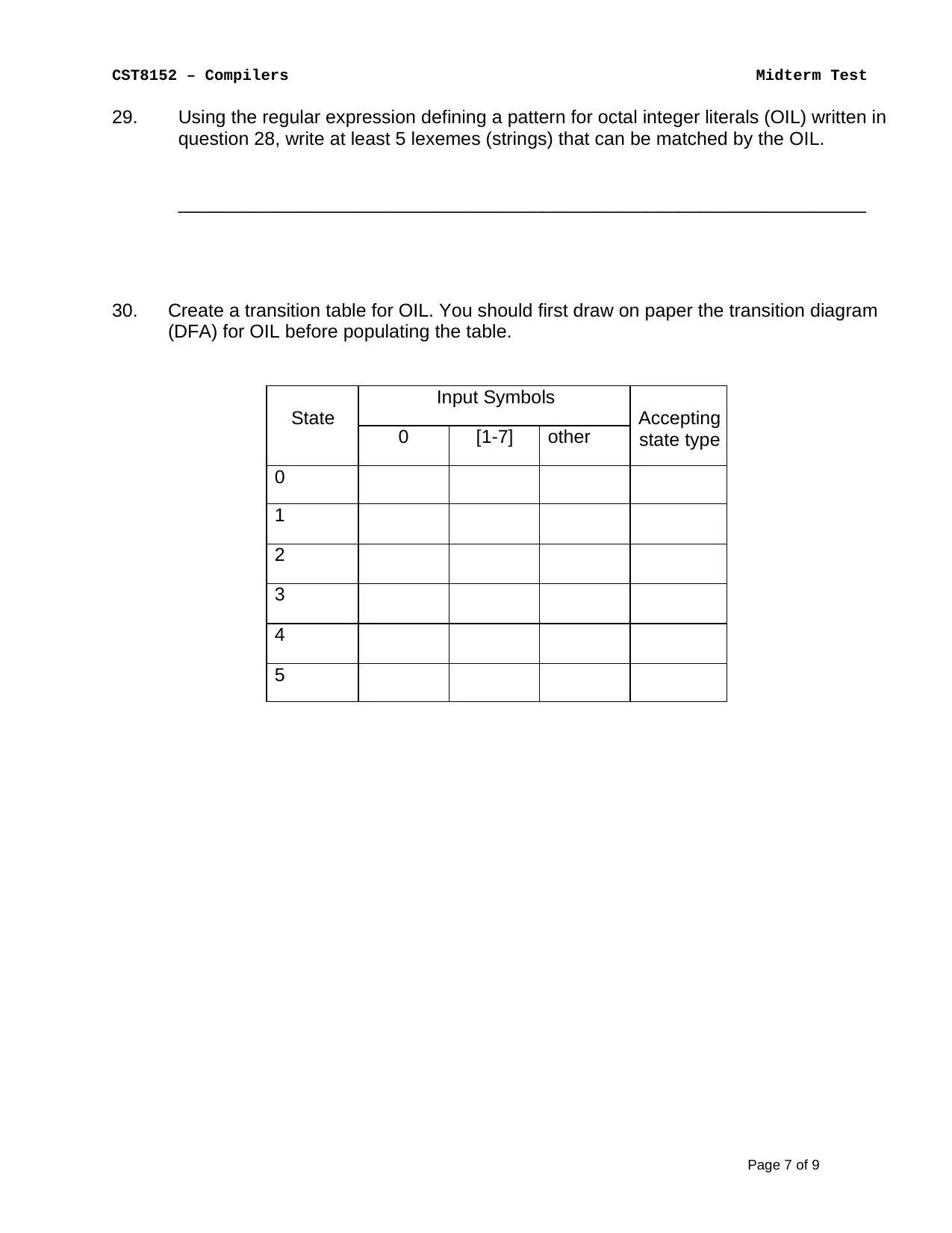
CST8152 – Compilers Midterm Test
Page 7 of 9
29. Using the regular expression defining a pattern for octal integer literals (OIL) written in
question 28, write at least 5 lexemes (strings) that can be matched by the OIL.
__________________________________________________________________
30. Create a transition table for OIL. You should first draw on paper the transition diagram
(DFA) for OIL before populating the table.
State
Input Symbols
Accepting
state type0 [1-7] other
0
1
2
3
4
5
Page 7 of 9
29. Using the regular expression defining a pattern for octal integer literals (OIL) written in
question 28, write at least 5 lexemes (strings) that can be matched by the OIL.
__________________________________________________________________
30. Create a transition table for OIL. You should first draw on paper the transition diagram
(DFA) for OIL before populating the table.
State
Input Symbols
Accepting
state type0 [1-7] other
0
1
2
3
4
5
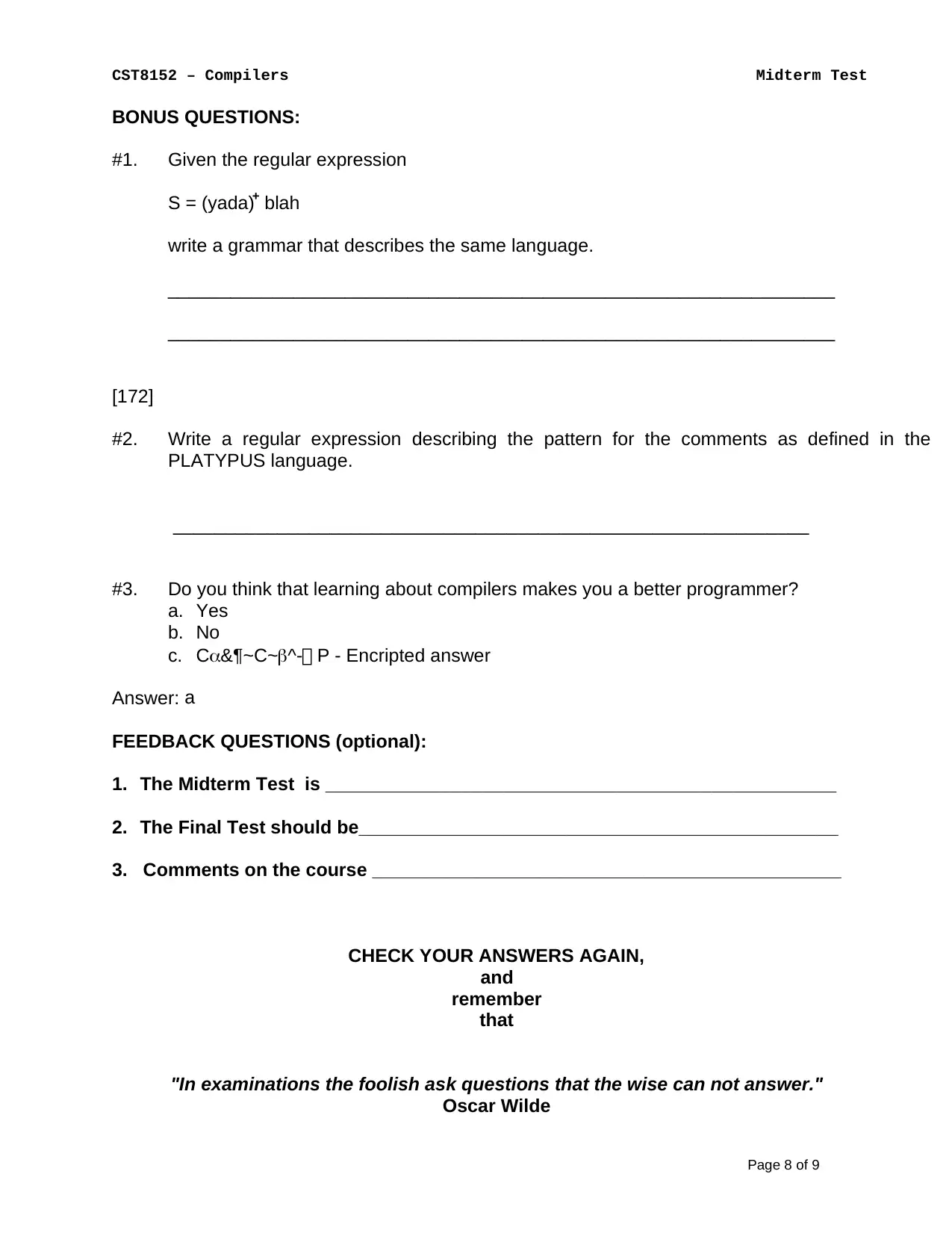
CST8152 – Compilers Midterm Test
Page 8 of 9
BONUS QUESTIONS:
#1. Given the regular expression
S = (yada)+ blah
write a grammar that describes the same language.
________________________________________________________________
________________________________________________________________
[172]
#2. Write a regular expression describing the pattern for the comments as defined in the
PLATYPUS language.
_____________________________________________________________
#3. Do you think that learning about compilers makes you a better programmer?
a. Yes
b. No
c. Cα&¶~C~β^- P - Encripted answer
Answer:
FEEDBACK QUESTIONS (optional):
1. The Midterm Test is _________________________________________________
2. The Final Test should be______________________________________________
3. Comments on the course _____________________________________________
CHECK YOUR ANSWERS AGAIN,
and
remember
that
"In examinations the foolish ask questions that the wise can not answer."
Oscar Wilde
a
Page 8 of 9
BONUS QUESTIONS:
#1. Given the regular expression
S = (yada)+ blah
write a grammar that describes the same language.
________________________________________________________________
________________________________________________________________
[172]
#2. Write a regular expression describing the pattern for the comments as defined in the
PLATYPUS language.
_____________________________________________________________
#3. Do you think that learning about compilers makes you a better programmer?
a. Yes
b. No
c. Cα&¶~C~β^- P - Encripted answer
Answer:
FEEDBACK QUESTIONS (optional):
1. The Midterm Test is _________________________________________________
2. The Final Test should be______________________________________________
3. Comments on the course _____________________________________________
CHECK YOUR ANSWERS AGAIN,
and
remember
that
"In examinations the foolish ask questions that the wise can not answer."
Oscar Wilde
a
⊘ This is a preview!⊘
Do you want full access?
Subscribe today to unlock all pages.

Trusted by 1+ million students worldwide
1 out of 9
Related Documents
Your All-in-One AI-Powered Toolkit for Academic Success.
+13062052269
info@desklib.com
Available 24*7 on WhatsApp / Email
![[object Object]](/_next/static/media/star-bottom.7253800d.svg)
Unlock your academic potential
Copyright © 2020–2025 A2Z Services. All Rights Reserved. Developed and managed by ZUCOL.




